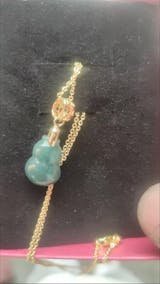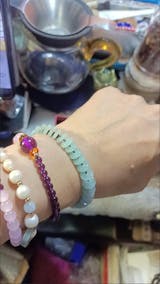Is It Correct for Men to Wear Guanyin and Women to Wear Buddha?
Introduction
In traditional culture, wearing jade ornaments is not just about beauty; it carries deep symbolic meaning and philosophical ideas. The saying “Men wear Guanyin, and women wear Buddha” is one such cultural tradition, with profound cultural significance behind it. This practice is more than just a simple wearing habit—it is a deep understanding of life, spiritual cultivation, and the harmony of the universe. By exploring the phonetic meanings, yin-yang balance, and spiritual concepts, we can better understand the essence of this cultural practice.

1. Phonetic Symbolism
The tradition of "Men wear Guanyin, and women wear Buddha" actually carries a strong phonetic symbolism, as "Guanyin" and "Guan Yin" (official seal) sound similar, while "Buddha" and "fortune" are also homophones. Here, "Guanyin" is associated with the male's prosperous career and success, while "Buddha" symbolizes blessings for women, bringing vast fortune that lasts for generations.
Historically, men often traveled far for business, exams, or military service, and their personalities could be more impulsive. Guanyin, often depicted as a female figure, represents compassion and gentleness, symbolizing a hope that men will remain calm, gentle, and composed in difficult situations. Therefore, wearing a Guanyin amulet for men expresses the hope for rationality and calmness in their actions.
For women, “wearing Buddha” refers not to Shakyamuni, but to Maitreya Buddha, who is known as the “future Buddha.” Maitreya’s image is often portrayed with a full belly and a smile, representing tolerance and blessings. Ancient people believed that women’s personalities could sometimes be narrow, and Maitreya symbolizes openness and abundance. This encourages women to cultivate an open and peaceful heart, thus creating a harmonious family and life. Maitreya’s saying, “A big belly can accommodate everything, and a smile can bring happiness,” teaches that only through tolerance can family and fortune thrive.

2. The Concept of Yin and Yang
The tradition of “Men wear Guanyin, and women wear Buddha” is closely related to the concept of yin and yang in Daoist and I Ching philosophy. In these traditions, men represent the yang, and women represent the yin. Guanyin, as a female deity, embodies yin, while Buddha represents the male, embodying yang. Therefore, the practice of wearing Guanyin for men and Buddha for women is intended to balance the wearer’s yin and yang energies, bringing harmony between the two.
Whether it is cultivating one’s character or seeking balance in life, the equilibrium of yin and yang is essential. Only by achieving harmony between the two can the body and mind achieve true unity. This practice of wearing amulets is not just symbolic on the surface but also reflects the deeper cultural aspiration for inner and outer harmony. Both Guanyin and Maitreya Buddha are seen as protective figures that help individuals overcome difficulties and bring peace.
Guanyin, as a female figure, represents yin, and Maitreya Buddha, as a male figure, represents yang. Together, they embody the balance of yin and yang, symbolizing harmony in the universe.

3. The Importance of Devotion
Although the tradition of “Men wear Guanyin, and women wear Buddha” has been passed down for centuries, it is important to note that Buddhism does not specifically encourage wearing Buddha or deity figures as amulets. Guanyin is a Bodhisattva, and to save all beings, she manifests in different forms, including male and female forms. According to the Shurangama Sutra, Guanyin manifests in 32 different forms to suit the different needs of sentient beings, including male, female, noble, commoner, and even beggars. Therefore, there is no fixed image of Guanyin.
The image of Guanyin is subtle and dignified, often seen as female in appearance, but this is not because Guanyin is inherently female. The Bodhisattva manifests in various forms based on the dispositions of sentient beings. The true significance of wearing these amulets lies in spiritual cultivation and personal growth, not the gendered imagery itself.
Maitreya Buddha, on the other hand, symbolizes eternal joy, tolerance, and optimism. His joyful smile is meant to bring peace and happiness to those who encounter it. His image is often placed in the main hall of temples, encouraging people to embody the positive qualities of Maitreya, such as compassion and cheerfulness.

4. Wearing Taboo
When wearing jade ornaments, whether it is Guanyin or Buddha, it is essential to follow certain guidelines and avoid taboos. The purpose of wearing ornaments is to bring good luck and protection, so it is important to adhere to some principles:
-
Avoid Changing Ornaments Frequently
The longer you wear a jade ornament, the more spiritual energy it gathers. Thus, it is essential to avoid changing ornaments frequently. Jade should be worn consistently, and not thrown or placed carelessly. Respect for the ornament is key to its energy and benefits. -
Don't Wear Ornaments Without Thought
Some people may casually wear jade ornaments without considering whether they align with their personal energy. Wearing a piece that clashes with one’s energy can bring the opposite of the desired effect. For example, men should wear Guanyin and women should wear Buddha for balance. It is essential not to wear ornaments thoughtlessly, as this can diminish their protective power. -
Avoid Wearing Broken Jade
It is commonly believed that broken jade absorbs misfortune to protect the wearer. However, once jade is broken, it loses its original protective energy. If it is not repaired, the jade will no longer offer blessings, and wearing broken jade can also pose a risk of injury. -
Avoid Wearing Someone Else’s Jade
Jade ornaments have unique energy and symbolism. Wearing someone else’s jade does not provide protection for the wearer but instead may serve to protect the original owner. Therefore, it is better not to wear jade that is not personally yours.
5. How to Choose the Right Ornament
Choosing a good jade ornament is not easy. The quality of the carving is crucial. A well-carved Guanyin or Maitreya Buddha brings joy and positive energy to the wearer. Here are some key factors to consider when choosing an ornament:
-
Exquisite Carving
The most obvious feature of a jade ornament is its carving. A finely crafted ornament brings comfort and joy to the wearer. Poorly carved jade, on the other hand, can make the wearer feel uneasy and uncomfortable. -
No Flaws on the Face
While most jade ornaments may have some natural flaws, it is important that no flaws appear on the face of Guanyin or Maitreya Buddha. Any imperfections here can impact the image and diminish the protective power of the ornament. -
Clear and Bright Color
The color of jade should be balanced, bright, and vibrant, giving the ornament a sense of vitality. It should not be too dark or dull, especially for younger wearers, as these colors may feel overwhelming.

Conclusion
The tradition of “Men wear Guanyin, and women wear Buddha” is more than just a cultural practice—it is a manifestation of the deep philosophical understanding of yin and yang, spiritual protection, and harmony with the universe. By following the guidelines of respectful wearing, understanding the deeper meanings, and choosing the right ornament, we can enhance the positive energies they bring into our lives. Whether you are wearing Guanyin or Maitreya Buddha, it is the intention and devotion that matters most in receiving their blessings and protection.
Related articles:
The Meaning of Different Colored Jade Buddha Necklaces
The Meaning and Value of a Jade Buddha Necklace
How Much Is Jade Worth and the Most Expensive Jade Types
Why Do People Wear Jade Bracelets: Meaning, Symbolism, and Benefits



























































